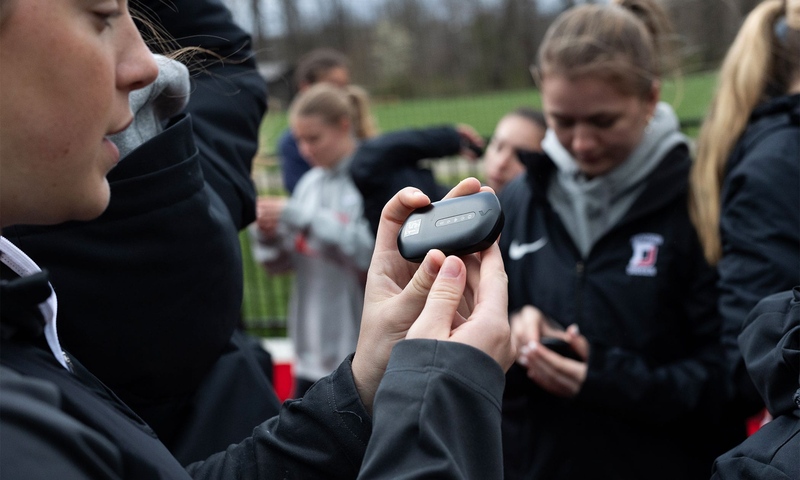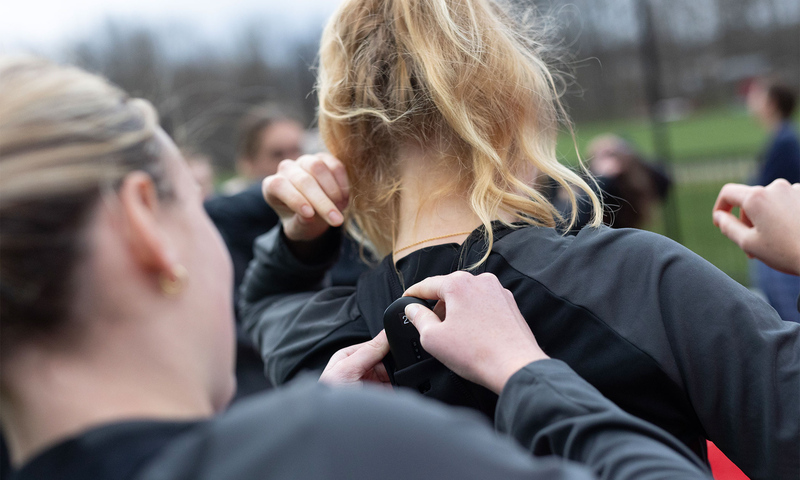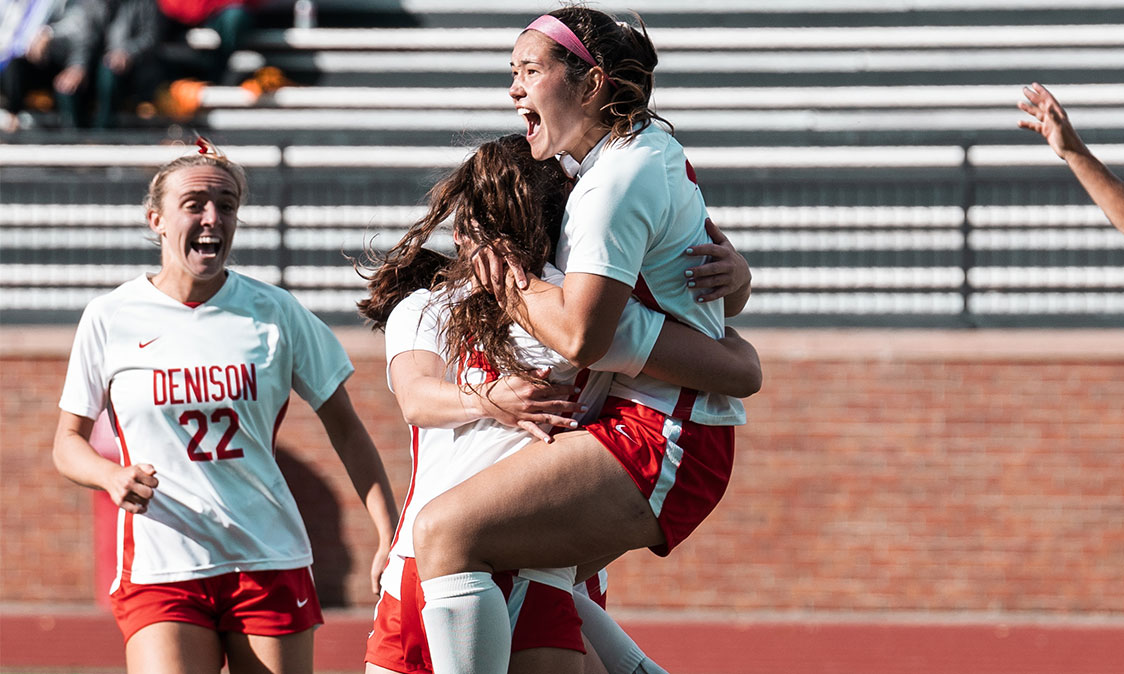Women’s soccer coach Sarah Brink felt a bit overwhelmed the first time she saw the 173-page data-driven breakdown of her team’s first season.
But as she leafed through the binder, syncing her memories of specific games with the corresponding GPS-generated stats, Brink marveled at the meticulous detail.
“Seeing data to back up how I was feeling during certain games was affirming,” she said.
Among the reasons Brink accepted the position in 2023 was her belief that Denison is at the forefront of innovative ideas. Here was evidence of that commitment — a deep dive into data courtesy of health, exercise, and sport studies (HESS) assistant professors Gail Murphy and Eric Winters.
Now, the athletic department and its academic partners are exploring ways to take their relationship to a different level.
Big Red athletics, along with HESS and data analytics, has been working to develop ideas for keeping varsity athletes healthier while also benefiting students eager to break into the growing fields of sports data and sports science.
One possibility is giving data analytics majors the opportunity to assist Big Red sports teams throughout a season. Instead of compiling end-of-year reports, the students would be trained to analyze data in almost real time.
Frequent reports from data analytics students could influence practice habits, improve fitness levels, and reduce fatigue and injuries.
“We refer to athletics as our living classroom, and this is an example of it,” athletic director Nan Carney-DeBord said. “This is leading-edge stuff. We have highly motivated coaches who are looking for the best methodology to help the performance of our athletes. Our ultimate goal academically is to create an environment conducive to launching our students into whatever field they choose.”
GAME CHANGER
While some major college programs employ student data analysts, few give them academic credits for their work. That’s among the ideas under consideration.
While the departments weigh their options, Winters can’t help but think of the potential benefits for students.
“This would give us a chance to get outside the four walls of the classroom, where you are doing just theory,” Winters said. “That’s obviously necessary and important, but we want to connect the practice to it. Practice is always more full and rich than learning about it in a book.”
Fundraising will be crucial to make this enterprise a reality
The athletic department is hoping to invest in more wearable technology, including additional GPS monitoring devices, which the women’s soccer players attach to lightweight vests beneath their uniforms.
Matthew Miller, associate director of data analytics, believes students would be eager to pursue studies that incorporate sports data analysis.
Students already are allowed to petition the department to create their own academic concentration; Miller said sports analytics is among the most popular alternatives.
“We’re all in agreement that there’s a viable curriculum and a plan to move forward if we get the resources we need,” Miller said. “And there’s definitely an employment demand for these types of skills.”
FINDING WHAT WORKS
Murphy and Winters laugh at the memory of their many animated discussions — just outside of the athletic director’s office — about the data they were collecting from soccer games and practices. The excitement made speaking with their inside voices challenging.
“We were hooked, and we drove poor Nan nuts talking about it,” Murphy recalled.
Combining forces with HESS and data analytics — two of the university’s most popular majors — immediately made lots of sense to the athletic director.
Murphy and Winters weren’t in a rush, however. They began thinking of an academic-athletic partnership in 2021 when the athletic department purchased its first GPS devices. Murphy was still coaching the women’s soccer team and didn’t want to commit to the project until turning the program over to Brink following the 2022 season.
From the start, they knew protecting the athletes’ identities was vital. The data analytics students wouldn’t see the names of the players they analyzed. No individual results would be posted.
Winters and Murphy learned quickly how easy it is to become paralyzed by the sheer volume of data points.
“You can go down a lot of rabbit holes,” Murphy said.
They used trial and error to determine what metrics were most relevant to women’s soccer, their test program. They focused on distance run by players as well as bursts of acceleration and deceleration.
Another important factor was learning how to communicate their findings. The 173-page report was filled with bar graphs and charts that made it simple for Brink to recognize trends from games and practices.
“When you are doing a school project, everyone in that class is aware of the technical stuff you are describing,” said Matt Iammarino ’18, an assistant developer and analytical football researcher for the Tennessee Titans. “But in any corporation, the NFL included, you have to be able to explain it in their language or the analysis can get lost.”
WEIGHTY MATTERS
The glass-enclosed weight room inside the Mitchell Center is the body shop of the athletic department. Beau Scott, director of sports performance, is tasked with shaping, contouring, and fine-tuning.
Even before the arrival of the GPS devices, Scott was demonstrating the value of big data in athletic circles.
Scott became an enthusiastic client of the data analytics program not long after it was founded in 2016. He employs several students each year to make sense of the metrics collected in the weight room.
A year ago, the department purchased a bilateral force plate, which athletes from every sport use at least once a week. To the untrained observer, the routine appears pedestrian: Athletes jump on a padded surface connected to a monitor.
But for student analysts, the force plate yields valuable metrics from a single jump. They also interpret data from other weight-room activities.
Scott is looking for trends in an athlete’s power, explosiveness, and fatigue, among other things. The results can help coaches adjust training.
“Several members of our team had some fatigue levels that were too high going into the NCAA championships,” swimming and diving coach Gregg Parini said. “The fact that Beau can give us that information in real time allows us to make informed decisions.”
ENDORSING IDEAS
Miller, the associate director of data analytics, made a phone call to a three-time Super Bowl champion in the spring.
Mike Frazier runs the analytics department for the Kansas City Chiefs. He also has a Denison connection — his father, Michael O. Frazier, was the university’s director of auxiliary enterprises and risk management from 2005 to 2007.
Miller said the Chiefs analyst has agreed to speak to Denison students in the near future. By then, ideas of the athletic-academic partnership might be fully formed.
The benefits to athletics and data analytics are obvious, but Winters insists HESS also would acquire valuable knowledge through data collection.
“We are intrinsically interested in taking what the data is saying and what’s happening on the field and looking at the quality of the athletes’ movements,” Winters said.
“We’re interested in trying to prevent injuries and flatten fatigue curves.”
Miller said the data analytics program is comprehensive enough that students would have little trouble finding work in adjacent fields if they didn’t want to make a career out of interpreting sports data. Either way, the experience they receive in working with actual teams would look great on a resume.
Time will tell whether the athletic department’s discussions with HESS and data analytics lead to a formal academic proposal for faculty consideration. If they need an endorsement, however, Brink sounds willing to provide it.
“What they have done is awesome,” Brink said. “After reading the report, we’re working hard on our conditioning this spring. I can point to the data and say, ‘Here are the games we struggled in — games where we weren’t sprinting enough.’ The analytics add another layer. It’s not just me saying it.”








